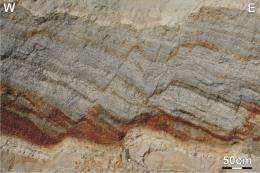Underground Forces: Deformation Processes in Gravel Deposits

Deformation bands in the gravel layers of the Eisenstadt-Sopron Basin form as a result of heterogeneous displacement in the surrounding sediment. This is caused by gradients in the deformation intensity, which occur both parallel and perpendicular to a fault.
These findings from a project funded by the Austrian Science Fund (FWF) will help scientists to reach a better understanding of both basic geological processes and the formation and structure of oil and water reservoirs.
As impressively demonstrated by the Himalayas and Pacific oceanic trenches, tectonic forces can really get things moving. However, even these dramatic geological manifestations move just a few millimetres or centimetres per year. Other phenomena associated with geological forces, known as deformation bands, are also subject to movement on a similar scale. These bands arise in soft porous rocks, such as sandstone. They occur where coarse-grained rocks are displaced by the shear forces of the overlying or underlying rock horizons, or undergo a change in volume. In contrast to what is known as a fault, in which the layer of rock ruptures, in the deformation bands, sediment grains are merely fractured or reorganised. The porosity of the rock and, therefore, its permeability to fluids, changes as a result of this process. Deformation bands thus contribute to the formation and structure of oil or water reservoirs. Attaining a better understanding of their effect on the surrounding rock is the aim of a project being carried out at the Department for Geodynamics and Sedimentology at the University of Vienna.
As part of this study, project leader Dr. Ulrike Exner and her team successfully demonstrated that, due to their relatively coarse grain size, deformation bands in gravels in the Eisenstadt-Sopron Basin near Lake Neusiedl on the Austrian-Hungarian border display a gradient in the strain intensity. This gradient runs from the undeformed neighbouring rock to the middle of the deformation band. As Dr. Exner outlines: "The stresses responsible for this act perpendicular of the deformation band. However, we discovered that a displacement gradient also exists parallel to the fault zone. The largest displacement can be measured in the middle of the deformation band. It decreases above and below this point towards the tips of the band." The presence of these two differently oriented displacement gradients causes folding in the surrounding sediment layers.
Dr. Exner explains the further effects of these heterogeneous deformations in the rock as follows: "The surrounding rock horizons begin to deform. This effect is known as reverse drag. In closely-spaced deformation bands, such drags can even overlap. The resulting geometrical patterns become increasingly complex." However, as Dr. Exner also states, models exist that can explain these patterns: "The so-called domino model explains these patterns in terms of the rotation of blocks of rock between the different deformation bands. Because the rock is still soft and the deformation proceeds very slowly, the behaviour of these blocks is ductile and they are easily deformed."
In the deformation bands examined as part of this project, the ratio between the displacement of the layers of rock pushing against each other and the length of the deformation bands is striking. These ratios, which range from 1:100 to 1:10, are unusually large. According to Dr. Exner, this could facilitate the generation of reverse drag.
Despite the fact that the processes studied by Dr. Exner unfold below the surface of the earth, her work is of direct and practical relevance to everyday life above ground: deformation bands mainly form in porous rock which, due to the presence of numerous pores, also acts as a reservoir for oil or water. Deformation bands alter porosity and can therefore influence the extraction of oil or water. Moreover, the relevance of this FWF project also extends to heavenly heights: the calcareous sandstone, also referred to as Leithakalk (Miocene limestone found in Central Europe), from which St. Stephen's Cathedral in Vienna is built, originates from the Eisenstadt-Sopron Basin. Its porosity - and thus also its response to environmental impacts and protective measures - is also influenced by deformation bands.
More information: Data were presented at the "European Geosciences Union General Assembly 2010", 2 - 7 May in Vienna, Austria.
Provided by Austrian Science Fund













